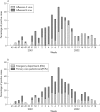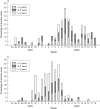Burden of influenza in healthy children and their households
- PMID: 15499051
- PMCID: PMC1719733
- DOI: 10.1136/adc.2003.045401
Burden of influenza in healthy children and their households
Retraction in
-
Burden of influenza in healthy children and their households.Arch Dis Child. 2006 Sep;91(9):797. doi: 10.1136/adc.2003.045401corr1. Arch Dis Child. 2006. PMID: 16969914 Free PMC article. No abstract available.
Abstract
Objective: A prospective, multicentre study was conducted to evaluate the burden of laboratory confirmed influenza in healthy children and their household contacts.
Methods: The patients were enrolled in four emergency departments (EDs) and by five primary care paediatricians (PCPs) in different Italian municipalities 2 days a week between November 1, 2001 and April 30, 2002. The study involved 3771 children less than 14 years of age with no chronic medical conditions who presented with a respiratory tract infection in EDs or PCP outpatient clinics during the study period. Nasopharyngeal swabs were collected for the isolation of influenza viruses and RNA detection. Information was also collected concerning respiratory illnesses and related morbidities among the study children and their household contacts.
Results: Influenza virus was demonstrated in 352 cases (9.3%). In comparison with the influenza negative children, those who were influenza positive had an older mean age, were more often attending day care centres or schools, more frequently experienced fever and croup, received more antipyretics, and had a longer duration of fever and school absence. Furthermore, their parents and siblings had more respiratory illnesses, received more antipyretics and antibiotics, needed more medical visits, missed more work or school days, and needed help at home to care for the ill children for a longer period of time.
Conclusions: Influenza has a significant clinical and socioeconomic impact on healthy children and their families. Prevention strategies should also focus on healthy children regardless of their age because of their role in disease transmission.
Figures


References
Publication types
MeSH terms
LinkOut - more resources
Full Text Sources
Medical
Miscellaneous
